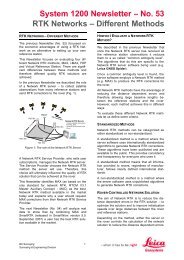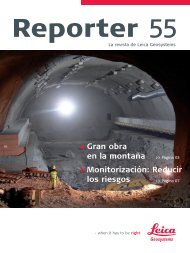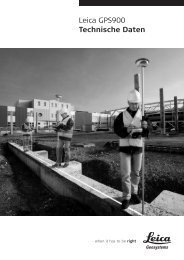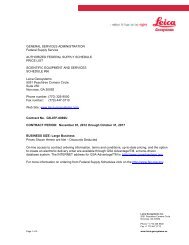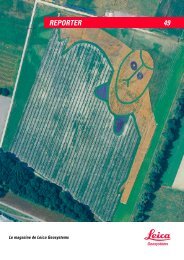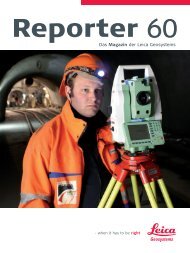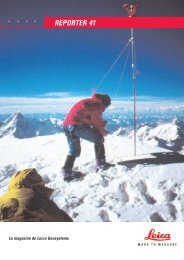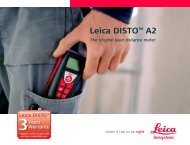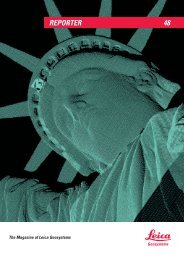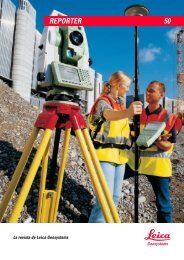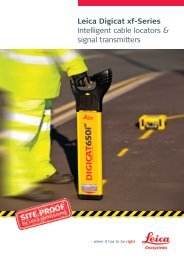Reporter No 60, May 2009, English (PDF 2,58 MB) - Leica ...
Reporter No 60, May 2009, English (PDF 2,58 MB) - Leica ...
Reporter No 60, May 2009, English (PDF 2,58 MB) - Leica ...
Create successful ePaper yourself
Turn your PDF publications into a flip-book with our unique Google optimized e-Paper software.
As the world becomes more ‘spatially aware’ there is<br />
an ever increasing demand to measure and monitor<br />
our environment, be it for climate change, biodiversity,<br />
or urban development. Such activities heighten<br />
the need for value-added products, beyond just<br />
imagery, to quantify key features present in geographic<br />
data. The depth and quality of information<br />
captured using the <strong>Leica</strong> ADS40 takes us a giant leap<br />
towards providing the required measurements.<br />
Landcover<br />
Landcover information is a crucial first step requirement<br />
as it can be used as a quantitative descriptor of<br />
the landscape, as well as a base to derive other information<br />
such as habitat maps and landuse. Traditionally,<br />
landcover information is extracted in two different<br />
ways: either automatically by classifying the<br />
“color” of a satellite image into its most appropriate<br />
class or manually by interpreting aerial photography<br />
based on color and contextual information.<br />
The satellite method usually gives a spatially coarse<br />
measurement but has the potential to identify quite<br />
specific classes quickly. The aerial photo method can<br />
create highly detailed mapping but is very labour<br />
intensive. Infoterra, using the ADS40 and the latest<br />
image classification technology, has moved towards<br />
a best-of-both-worlds solution using the “color” or<br />
“spectral” descriptor of the 4 channels, the high resolution,<br />
and height information for context.<br />
Object-based image classification is used to semiautomate<br />
this process whereby the imagery is segmented<br />
(separated into meaningful chunks) into<br />
areas of consistent color and texture. Each of these<br />
objects can then be assigned specifics such as color,<br />
texture and height, but also contextual information<br />
such as the difference to surrounding objects.<br />
Combining this technology along with the wide area<br />
coverage and radiometric consistency of the <strong>Leica</strong><br />
ADS40 allows Infoterra to tackle large areas and provide<br />
a National product.<br />
The specification of this classification was developed<br />
after reviewing numerous existing schemes both UK<br />
and European in origin (such as LCM2007, NLUD &<br />
CORINE), assessing market needs and iteratively trialling<br />
the classification technology to see what was<br />
possible and robust. A generic, thematic approach<br />
was taken while retaining the high spatial resolution<br />
of the original data. The prime reason this approach<br />
was taken is that it allows a high resolution measure<br />
of the basic landcover make-up, while being suitable<br />
for bespoke thematic upgrades to specific client<br />
requirements. The resultant product from Infoterra<br />
is LandBase.<br />
LandBase provides three Level 1 classes and ten Level<br />
2 classes captured to a MMU (Minimum Mapping<br />
Unit) of 50 m² allowing analysis down to individual<br />
building and tree level. Level 2 classes include: sea<br />
>><br />
The Global Magazine of <strong>Leica</strong> Geosystems | 19



